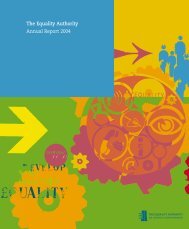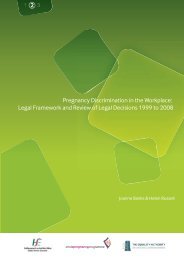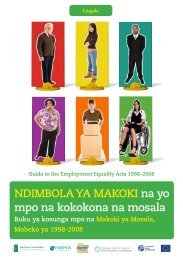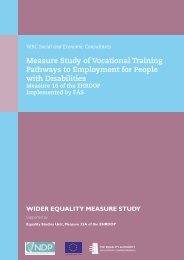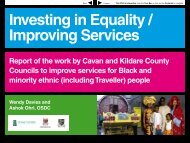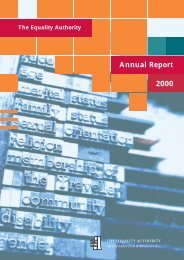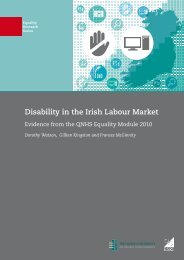Pregnancy and Employment: A Literature Review - Crisis Pregnancy ...
Pregnancy and Employment: A Literature Review - Crisis Pregnancy ...
Pregnancy and Employment: A Literature Review - Crisis Pregnancy ...
You also want an ePaper? Increase the reach of your titles
YUMPU automatically turns print PDFs into web optimized ePapers that Google loves.
<strong>Pregnancy</strong> <strong>and</strong> <strong>Employment</strong>: A <strong>Literature</strong> <strong>Review</strong><br />
the ideal worker. The findings are judged to support the theory of status-based discrimination, which suggests that<br />
lower-status actors will be judged more harshly; because good performance among low-status actors runs counter<br />
to expectations, their performance is more critically scrutinised. In other words, “the st<strong>and</strong>ard used to evaluate<br />
workers is systematically biased in favour of high status groups” (Correll et al, 2007, p1302).<br />
2.8 Conclusion<br />
Unfair treatment<br />
The studies outlined above suggest that pregnant women are indeed potentially exposed to a wide range of<br />
negative treatment in the workplace. Estimating the precise number of women who experience such problems is<br />
difficult. The cases that appear before legal tribunals represent only the tip of the iceberg. Probably the two most<br />
relevant estimates of the rate of such discrimination come from the 2007 National Maternity Rights Survey (MRS)<br />
(La Valle et al, 2008) <strong>and</strong> the EOC/Adams et al (2005) study. The MRS study found that 11% of women felt they had<br />
been treated unfavourably during pregnancy, while the EOC/Adams et al study estimated that 45% of women had<br />
experienced tangible discrimination.<br />
The results from the MRS are more statistically robust as they are based on a nationally representative r<strong>and</strong>om<br />
sample of women with young children, whereas the EOC study did not use a representative sampling frame. 23 The<br />
two studies also differ in the way in which the questions on discrimination or unfavourable treatment were framed.<br />
In the MRS, women had to respond spontaneously to a question on whether they had been treated unfairly due<br />
to their pregnancy, without any prompts as to what this treatment might have entailed. In contrast, the EOC study<br />
showed women a list of experiences <strong>and</strong> asked if any applied to them. The women themselves did not define the<br />
treatment as unfair or unfavourable. In neither case can it be established that the experiences reported would pass<br />
a legal threshold of discrimination.<br />
While the extent of the problem is difficult to measure precisely, the research provides a somewhat more<br />
consistent view of the factors associated with increased risk of discrimination or unfavourable treatment.<br />
Nevertheless, the results on risk factors are far from conclusive due to the relatively small number of studies<br />
carried out <strong>and</strong> the lack of representative data. We highlight below some of the results that have recurred across<br />
more than one of the studies described.<br />
Higher risk in private sector: A number of sources, including the survey of employers (Young & Morrell, 2005a), the<br />
legal case studies <strong>and</strong> the EOC survey (Adams et al, 2005) suggest that women in the private sector face a greater<br />
risk of unfair treatment during pregnancy compared to those working in the public sector. Greater adherence to<br />
equality policies <strong>and</strong> formal recruitment <strong>and</strong> human-resource practices, as well as greater awareness of regulations<br />
around pregnancy at work, may account for lower rates of discrimination in the public sector. It was also argued<br />
that public-sector employers might be more likely to settle discrimination cases before they reach the courts.<br />
Less risk with flexible-work-practices culture: Flexible work practices were found to be associated with better<br />
treatment of pregnant workers in a number of the studies. Both the EOC survey <strong>and</strong> the 1996 <strong>and</strong> 2007 Maternity<br />
Rights Surveys (Callender et al, 1997; La Valle et al, 2008) found that women in firms without flexible working<br />
arrangements were more likely to have experienced problems with their employer concerning their pregnancy<br />
<strong>and</strong> maternity leave. The provision of flexible working options is likely to indicate that the employer is aware of the<br />
competing dem<strong>and</strong> facing employees outside of work <strong>and</strong> may also suggest a greater concern for employees’<br />
welfare more generally.<br />
Higher risk in small firms: Differences between small <strong>and</strong> larger employers were found in Young <strong>and</strong> Morell’s<br />
study of employers as well as by Adams et al (2005). Women in small firms had a higher risk of discrimination<br />
<strong>and</strong> employers in smaller firms expressed more negative views about pregnant workers <strong>and</strong> about dealing with<br />
pregnancy in the workplace. This latter effect is partly structural as employers in small firms do not have the same<br />
resources to cover employees on maternity leave.<br />
23 The EOC sample was reweighted to the relevant population but selection bias may remain a problem.<br />
PAGE 23




